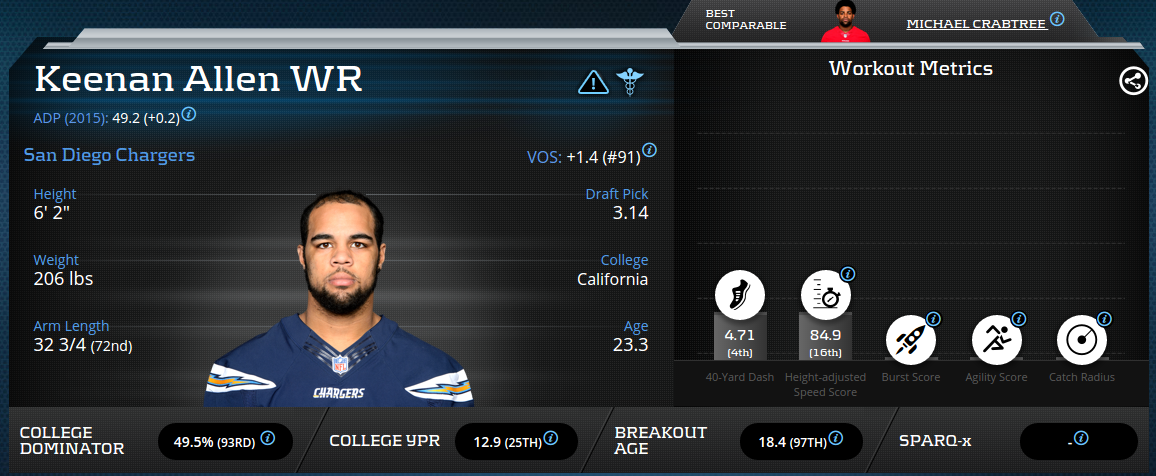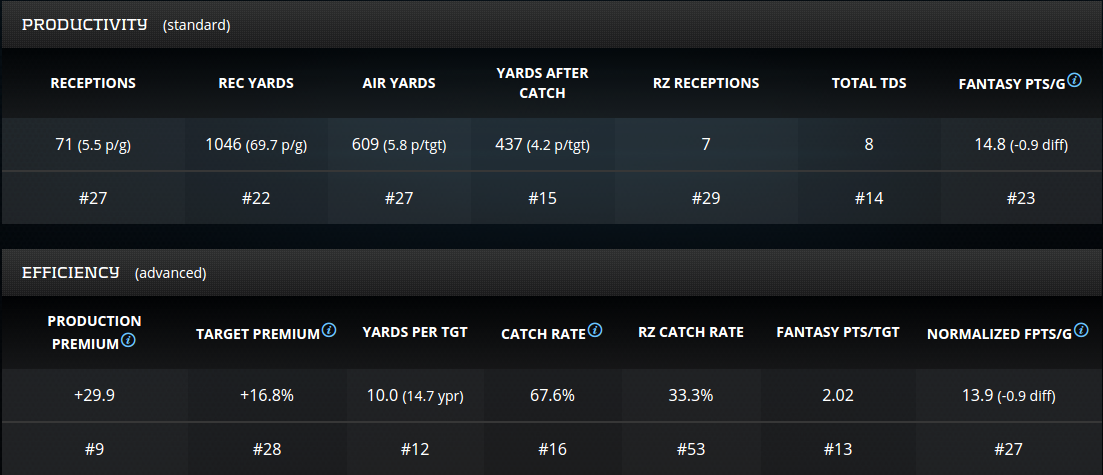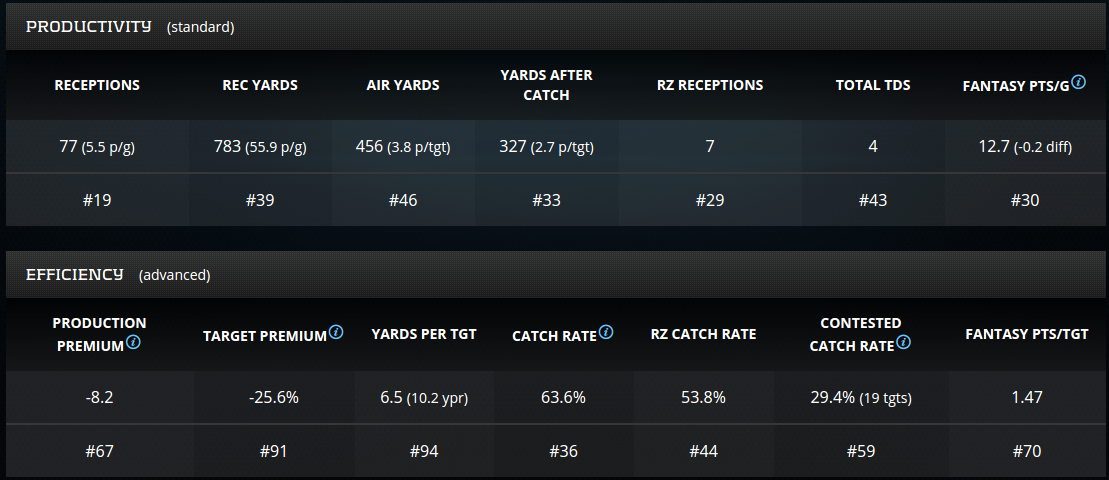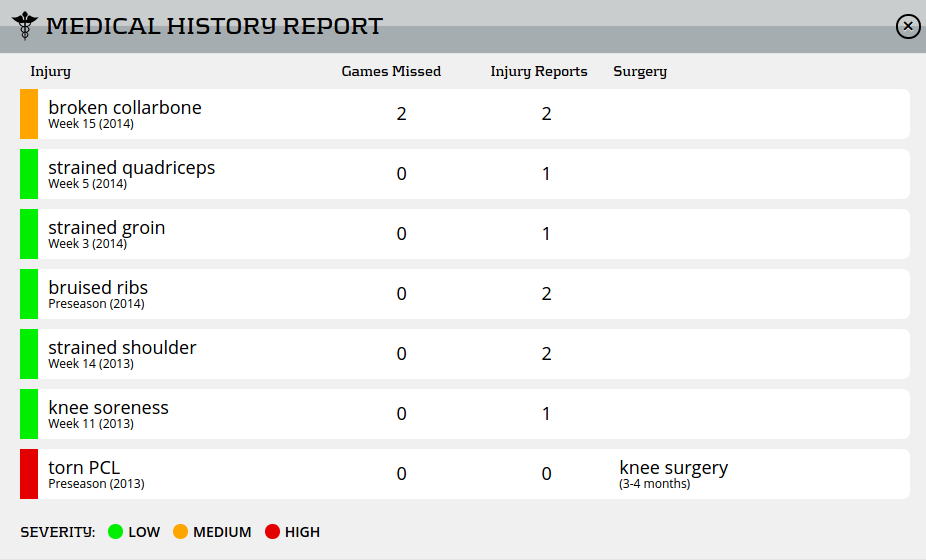In 2012, the San Diego Chargers, and Philip Rivers in particular, were coming off their worst season in a decade. The Chargers failed to reach .500 for the first time since Rivers was named their starting quarterback.
The San Diego wide receivers were a mess. Their leading receiver was Malcom Floyd with a career high 56 receptions. Danario Alexander couldn’t stay healthy and finished with 37 receptions. Eddie Royal did Eddie Royal things and sprinkled in 2 or 3 catches throughout the season to finish with 23. The entire San Diego WR corps in finished 2012 with about as many receptions as Wes Welker in a down year.
The 2013 Ascent
In the 2013 NFL Draft, the Chargers addressed the situation by selecting Keenan Allen with their third round pick. Allen was dominant in his sophomore season at Cal posting a 49.5-percent (93rd-percentile) College Dominator Rating. Prior to his junior season he suffered an offseason ankle injury playing basketball and missed all spring practices. His stats regressed in his final college season and he missed the last three games with a torn PCL, but draft scouts still liked his potential to transition to the NFL.
Keenan Allen’s workout metrics are underwhelming primarily, because he did not participate in the NFL Scouting Combine and was not 100-percent healthy during his pro day.
In his rookie season, Keenan Allen was expected to take the field with Floyd, Royal and another tantalizing young receiving prospect that missed all of 2012 with injury, Vincent Brown. Plans quickly changed as Malcom Floyd suffered a neck injury in Week 2 and was placed on injured reserve. Brown’s promise never materialized and perennial fantasy tease, Eddie Royal, scored 5 of his 8 touchdowns before Summer had transitioned into Fall.
Keenan Allen wasn’t a high profile rookie receiver entering the season due to his down final season at Cal and his knee injury. In his first year, Allen was the No. 71 wide receiver drafted in fantasy football leagues. He didn’t play Week 1 and was used sparingly in Week 2. In Week 3 after Floyd was lost for the year, Allen posted one reception for -4 yards .
Then, it all came together for Keenan Allen. He burst onto the national stage against “America’s Team” with a win against the Cowboys. In almost every way possible, Allen exceeded his expectations for productivity and efficiency. Keenan finished the season as the WR18 in fantasy.
The 2014 Collapse
It’s a common theme in fantasy football. A player outperforms his ADP in one season, and it is inherently assumed that his production will follow along an extrapolated upward trajectory in the next.
Underperform. Here’s your shovel. Start digging.
Overperform. There is no ceiling. Just imagine what this guy could do with more targets!
It also doesn’t hurt when you “win someone their league.” In the 2013 fantasy playoff weeks (14-16), Allen had 8 total receptions for 114 total yards and 5 touchdowns. Jackpot.
So what’s not to like?!? The consensus prior to the 2014 season seemed to be: Nothing. Based on his 2013 performance, Keenan Allen was selected as the 11th wide receiver off the draft board. Malcom Floyd returned to the team and stayed fully healthy for the first time in his career. Floyd’s return relegated Allen to the flanker position for the Chargers and allowed him to increase his targets on short and intermediate routes.
All of his opportunity metrics increased in 2014 over 2013. With the additional attention given, Allen’s productivity and efficiency plummeted across the board last season. Keenan Allen‘s sophomore campaign resulted in 15 yards less per game. 2 less air yards per target. And he finished the season as the WR35. Most notably, his Production Premium (PlayerProfiler‘s situation-agnostic player efficiency metric) declined from +29.9 to -8.2 — a truly dramatic year-over-year collapse.
Durability Concerns
His 2014 season was cut short due to a broken collarbone. Keenan Allen has graced the NFL injury report quite frequently in his short career.
So which Keenan Allen is the player we can expect to see this season? The efficient, productive Keenan or the oft-injured, ineffective Keenan?
2015 Outlook
The Chargers are expected to feature Keenan Allen, Floyd and newly acquired Steve Johnson. Johnson was extremely efficient with the 49ers last year, and I believe that Johnson’s arrival will have a negative impact on Keenan’s opportunity. Johnson and Allen have redundant profiles and I believe they’ll eat into each other’s target share which makes Johnson somewhat of a value in the late rounds.
Additionally, in recent history the Chargers passing game has had a focus on getting the ball to the tight end and running backs. With Danny Woodhead returning and uber-prospect Ladarius Green playing at least the first month in place of Antonio Gates there is a logjam for targets in the short and intermediate spots on the field. Maybe Keenan can carve out a role in the deep game as he did when he was a rookie, but Malcom Floyd, Dontelle Inman, and perhaps even a roster long shot Tyrell Williams, have better-suited skill sets for the deep quadrants of the football field.
Keenan Allen appears to be a king without a castle. I liken the 2015 San Diego Chargers wide receiver corps to the 2014 Arizona Cardinals with the role of Michael Floyd played by Keenan Allen. We all know how that story ended.
Conclusion
Keenan Allen is currently being drafted as the No. 22 wide receiver off the board, and I am skeptical. While this year’s draft slot is more reasonable than last year’s, I believe Allen is still being over-drafted.
Keenan Allen is a fantasy WR3 on his way to the shepherd’s gala in WR2 clothing. You’ve been warned.
Aaron Butler is an unapologetic New England Patriots fan and a contributor for RotoViz and PlayerProfiler.
Follow @RIPatriot






